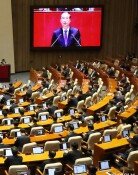What 3 factors led to N.Korea`s failed rocket launch Fri.?
What 3 factors led to N.Korea`s failed rocket launch Fri.?
Posted April. 14, 2012 05:11,
Experts raised suspicion over North Koreas failed launch of a long-range rocket Friday.
The North invited foreign reporters to the launch site to claim a transparent launch of a satellite, but failed to even inform reporters of the launch on the day of liftoff. Pyongyang also pushed ahead with the launch despite less than optimal weather and having a few days before its proposed deadline of Monday.
① Failure to show rocket to foreign reporters on launch date
North Korea took more than 50 foreign reporters invited from a number of countries to the village of Dongchang-ri, North Pyongan Province, to directly show them the rocket and launch site Sunday. It also showed them the satellite to be loaded on the rocket.
The foreign reporters, who were in Pyongyang on Friday when the rocket was launched, were completely unaware of liftoff. The North not only failed to inform them of the launch in advance, but also distracted them by saying a city tour was scheduled Friday.
Learning of the ill-fated launch through news reports from Seoul, the foreign reporters asked Pyongyang belatedly if the rocket had been launched. A source with the Norths Space Science Committee declined to answer, saying I was unaware of it.
At the media center of Ryangkakdo Hotel in Pyongyang, where the reporters are staying, a large screen was installed Thursday but was not on when the rocket was launched. So the North, which was not confident of a successful launch, might have had no intention to broadcast the launch live in the first place.
② Decision to launch on a foggy day
A source from the (South) Korea Meteorological Administration said, According to the Sinuiju weather center that is close to the Dongchang-ri station, thick fog with visibility of 500 meters was cast in the area at 7:40 a.m. Friday.
Jang Yeong-geun, a professor at Korea National Aviation University in Seoul, said, A rocket can be launched at night, but it`s difficult to understand why North Korea, which has a relatively low technological capacity, risked the unfavorable weather condition of fog at the Dongchang-ri station, which it used for the first time.
The better choice would have been a daytime launch to allow solar cell panels on the satellite Kwangmyongsong-3, which the North sought to put into orbit, to adequately charge and when sunlight shines for extended hours.
The North launched the Kwangmyongsong-1 at 12:07 p.m. in 1998 and the Kwangmyongsong-2 at 11:30 a.m. in 2009. Yet Pyongyang opted to launch the Kwangmyongsong-3 early in the morning this time.
For this reason, speculation is rising that the rocket might have had a technological defect that made a delay in the launch impossible. This is because the North started to veil the top section of the rocket with a camouflaged cover from Wednesday.
③ Advance of scheduled launch by three days
When the North announced its plan to launch a rocket on March 15, it suggested a date between April 12 and 16. So Pyongyang proceeded with the launch despite having three days left before its deadline.
North Korea is believed to have launched the rocket Friday, nonetheless, because there was no sign that weather conditions would improve anytime soon. Dongchang-ri was forecast to see cloudy and foggy conditions Saturday and Sunday, similar to the weather Friday.
A South Korean official said, however, More than anything, the North most likely conducted a celebratory firing to mark the convening of the Supreme Peoples Congress Friday afternoon and the centennial birthday of the country`s founder Kim Il Sung that falls on Sunday.
shcho@donga.com







